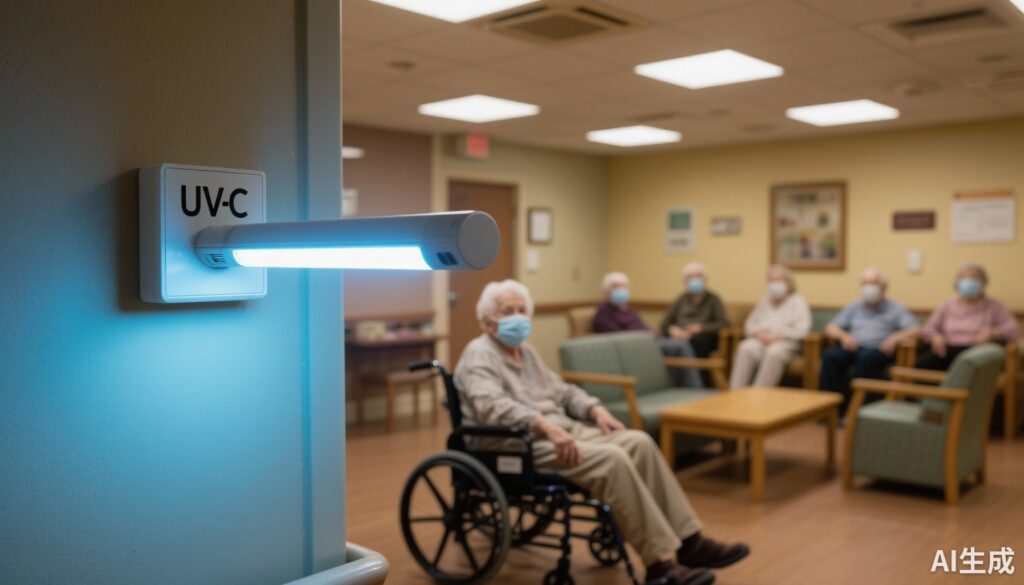Highlight
• Infectious outbreaks in long-term care facilities (LTCFs) significantly impact older adults, with high hospitalization and mortality rates due to respiratory viruses.
• Airborne transmission is a key but inadequately addressed route of respiratory virus spread in LTCFs.
• This large, multicenter randomized clinical trial tested whether germicidal ultraviolet (GUV) light in common areas reduces the incidence of acute respiratory infections (ARIs) in older adults residing in LTCFs.
• While the primary outcome showed no significant reduction in ARI rates per treatment cycle with GUV, secondary time-series analysis demonstrated a modest but statistically significant overall decline in ARI numbers during intervention periods.
• GUV may serve as a complementary approach to existing infection control practices in LTCFs.
Study Background and Disease Burden
Respiratory infections are a leading cause of morbidity and mortality among older adults, particularly those residing in long-term care facilities (LTCFs). Enclosed residential settings facilitate rapid spread of viral pathogens such as influenza, respiratory syncytial virus, and coronaviruses. These outbreaks result in high hospitalization rates and increased mortality, posing a significant public health challenge. Airborne transmission plays a major role in propagating infections within these environments. However, conventional infection control measures in LTCFs—including hand hygiene, surface disinfection, and isolation protocols—often inadequately address airborne spread. Novel adjunctive strategies are needed to mitigate virus transmission and improve resident outcomes.
Study Design
This multicenter, cluster-randomized, double-crossover clinical trial was conducted across four LTCFs in metropolitan and regional South Australia. Each LTCF was divided into two equally sized zones, averaging 44 beds per zone. These zones served as clusters randomized to two arms: intervention with active GUV appliances installed continuously in common, non-resident areas for six weeks, or control with inactive devices for the same period. Following each intervention or control period, a two-week washout was observed before crossover and alternate phase continuation. Seven cycles of this sequence were completed over 110 weeks (August 31, 2021, to November 13, 2023). Data were subsequently analyzed through December 2024.
The primary endpoint was the incidence rate of acute respiratory infections (ARIs) per zone per cycle. Secondary analysis evaluated longer-term trends in weekly infection rates using time-series autoregressive modeling.
Key Findings
Data from eight zones (four LTCFs), encompassing 211,952 bed-days, were analyzed. During the study, 596 ARIs were recorded, of which 475 (79.7%) occurred during intervention or control periods. The primary analysis revealed no statistically significant difference in ARI incidence rates between the GUV intervention and control arms. Specifically, the control zones experienced 4.17 infections per zone per cycle (95% confidence interval [CI], 2.43–5.91), whereas intervention zones recorded 3.81 infections per zone per cycle (95% CI, 2.21–5.41), yielding an incidence rate ratio (IRR) of 0.91 (95% CI, 0.77–1.09; P = .33).
However, the a posteriori secondary time-series analysis indicated a modest but statistically significant reduction in weekly ARI counts during intervention periods. Control zones reported an average of 2.61 ARIs per week (95% CI, 2.51–2.70), compared with 2.29 per week (95% CI, 2.06–2.51) in intervention zones. The mean difference was 0.32 fewer infections per week (95% CI, 0.10–0.54; P = .004).
No adverse events or safety concerns related to continuous GUV exposure in common areas were reported during the trial. This supports the feasibility of GUV appliance integration into LTCF environments.
Expert Commentary
This rigorous clinical trial provides valuable evidence for the role of germicidal UV light in mitigating respiratory viral transmission in LTCFs, a setting responsible for substantial morbidity and mortality among older adults. The lack of statistically significant reduction in incidence per treatment cycle may reflect challenges in achieving optimal viral inactivation solely through common-area air disinfection, given resident movement and other transmission pathways. Additionally, the crossover design and relatively brief intervention periods per cycle may have limited the detectable impact.
The modest but significant decrease in overall infection counts observed in secondary analyses suggests that cumulative or longer-term GUV exposure can confer meaningful benefits. Biological plausibility is supported by the extensive literature documenting UV-C light’s ability to inactivate a broad range of respiratory viruses by damaging viral nucleic acids. Furthermore, the installation of GUV devices offers a non-pharmacological, passive infection control layer that complements hand hygiene, vaccination, and environmental cleaning.
Limitations of this study include potential variability in adherence to other infection control measures during study periods, the confined geographic setting restricted to South Australia, and changes in circulating viral strains or community prevalence over the lengthy trial duration, which could confound results. Future research should explore optimal dosage, placement strategies, and integration with air ventilation systems. Evaluating cost-effectiveness and resident quality of life impact will further inform implementation decisions.
Conclusion
In summary, this large multicenter randomized clinical trial demonstrated that germicidal UV light appliances positioned in LTCF common areas did not significantly reduce acute respiratory infection incidence rates per cycle but were associated with a modest reduction in total infection numbers over the study period. These results support considering germicidal UV technology as an adjunct to strengthen established infection prevention and control strategies in LTCFs. Given the substantial burden of respiratory infections in vulnerable older adults, implementing GUV devices may contribute to healthier residential care environments and reduced viral transmission.
References
Shoubridge AP, Brass A, Crotty M, Morawska L, Bell SC, Flynn E, Miller C, Wang Y, Holden CA, Corlis M, Larby N, Worley P, Elms L, Manning SK, Qiao M, Inacio MC, Wesselingh SL, Papanicolas LE, Woodman RJ, Taylor SL, Rogers GB. Germicidal UV Light and Incidence of Acute Respiratory Infection in Long-Term Care for Older Adults: A Randomized Clinical Trial. JAMA Intern Med. 2025 Sep 1;185(9):1128-1135. doi:10.1001/jamainternmed.2025.3388. PMID:40720106; PMCID:PMC12305439.



